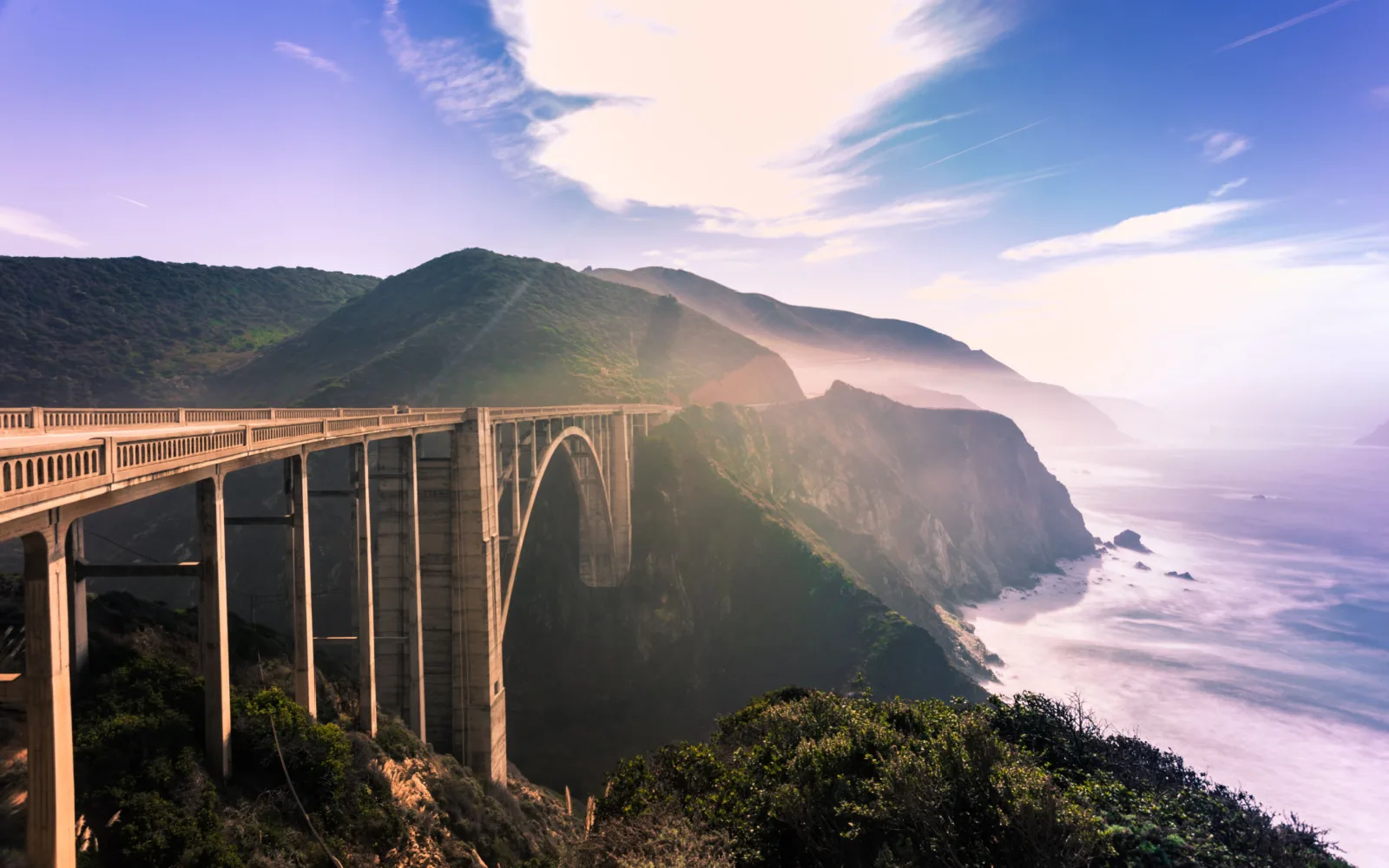What's the best time to visit Big Sur?
The best time to visit Big Sur is in summer and early fall for good weather and long days, or in winter (January to March) for budget-friendly options and McWay Falls. To avoid crowds, skip June to August, but prepare for traffic on Highway 1 and possible weather issues.
Big Sur delivers jaw-dropping natural vistas to enjoy over thousands of square miles of untouched wilderness. So many of California’s iconic views reside within the this area, from the Highway 1 coastal road trip to natural springs and waterfalls.
Millions of tourists visit this region each year, whether it is as part of a long coastal road trip or a visit to this unforgettable wilderness on its own. Traveling here requires lots of planning to make it a memorable and enjoyable visit.
We’ll help you determine the best time to visit Big Sur, including the busy and quiet seasons and other things to consider before making the trip to this California wonderland.
The Overall Best Time to Visit Big Sur
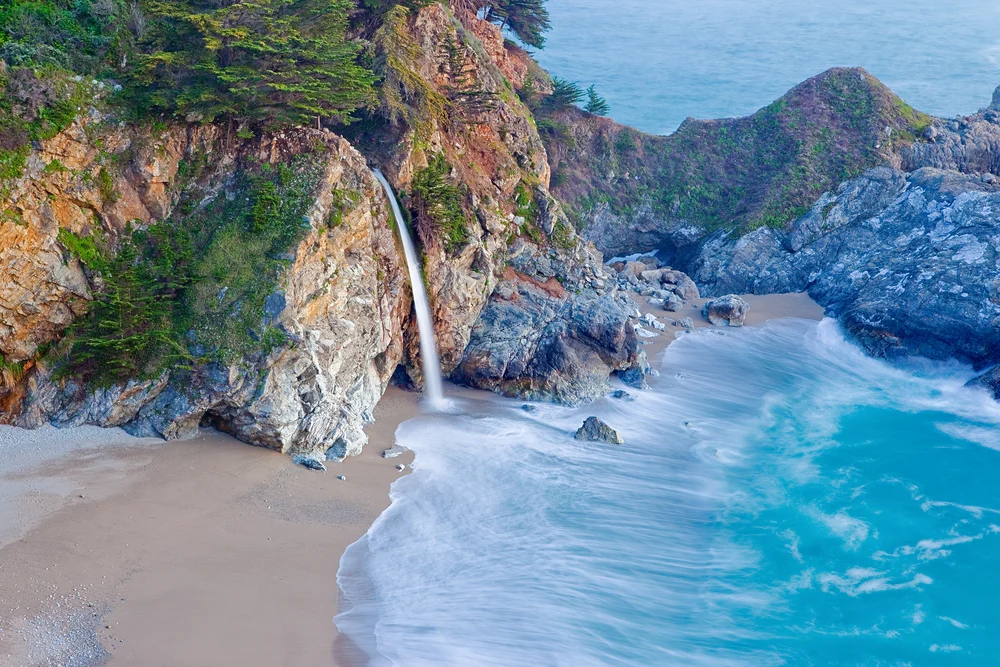
Doug Meek/Shutterstock
The overall best time to visit Big Sur is the summer and fall. These seasons provide a way to enjoy the beauty of the land during great weather and long days.
Because so many of Big Sur’s amazing attractions are outdoors, we recommend visiting when you can most enjoy Mother Nature. The central coast of California doesn’t offer the warm and sunny climate people associate with southern California.
In the region of Big Sur, cooler temperatures and fog reign supreme. To avoid unpleasant consequences from cool and wet weather, it is best to visit in the summer and early fall.
One benefit of visiting this region in the winter is the probability of seeing naturally-fed, 80-foot-tall McWay Falls. This natural waterfall only emerges in the wetter seasons of the year, like from January to March.
The limited rainfall most other months of the year makes McWay Falls unlikely to see in the summer and fall. Californians in central and northern California know to move with the rhythms of its micro-climates, including the marine layer of fog.
Typically fog cloaks much of the coast of this area, including Big Sur, until later in the morning. The sun shines reliably most of the year in the afternoon before fog rolls back in for the evening and overnight.
Tourists swarm Big Sur during all times of the year, leading to this location consistently landing on Fodor Travel’s list of places not to visit.
However, visitors can still enjoy themselves by avoiding some of the more congested areas of Big Sur. Avoid places like the area’s signature Bixby Bridge to skip the most annoying tourist areas.
Ready to Book?
Unlock Exclusive Discounts on Expedia.com!
Got Travel Insurance?
Protect yourself for unexpected interruptions.
Compare Plans We may be compensated when you book after clicking on one of our links.Cheapest Time to Visit Big Sur
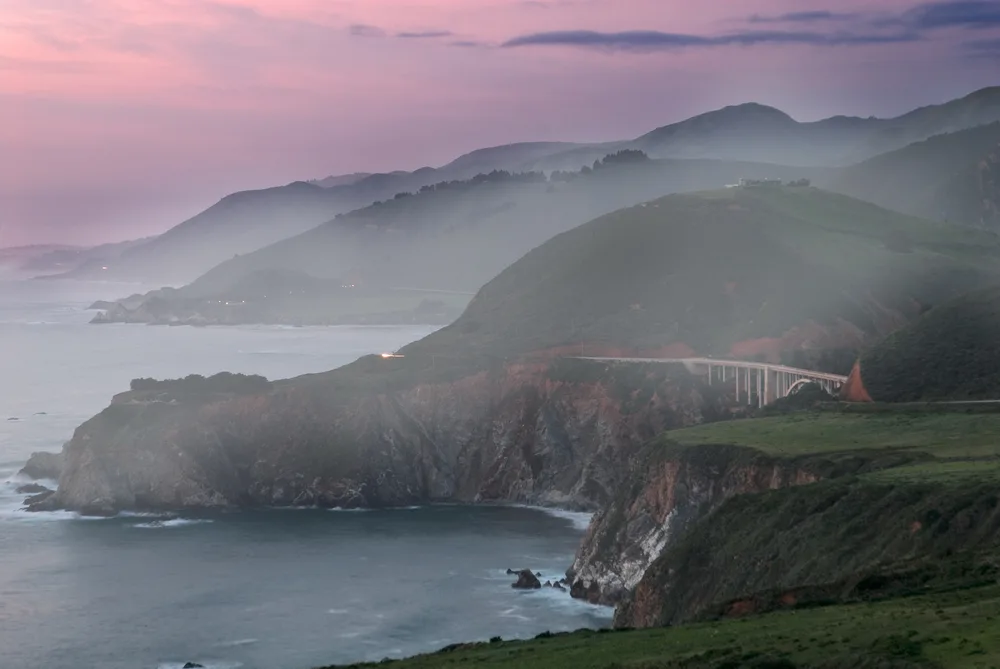
Always Wanderlust/Shutterstock
The cheapest time to visit Big Sur is early in the year, from January to March. These months offer typically cooler and darker days that are less appealing to most visitors.
However, the daytime hours provide great opportunities for sightseeing and hiking in Big Sur. Winter and spring are the off-season for Big Sur, which can result in many closed businesses within the villages dotting the Big Sur wilderness.
While that can make some amenities difficult to access, this also results in discounts for budget-conscious visitors. Nearby Monterey supports a small airport within about an hour’s drive of Big Sur. Cheaper flights arrive in nearby San Jose and San Francisco.
However, those destinations lie between two and a half to four hours away from Big Sur’s gorgeous redwoods and alluring beaches. One of the cheapest ways to get around Big Sur is by camping.
Camping in these cold early months of the year may be difficult for those who aren’t hardcore wilderness enthusiasts. However, campground reservations are easier to find and much cheaper to afford during this time of year.
Another way to save money while visiting Big Sur is to avoid the largest, most congested parks. These often have parking permits you have to buy at each park.
There are many tucked-away trails you can access spontaneously from Highway 1 that give you a secluded, beautiful experience for any hiker. California will soon overtake Germany for the fourth-largest economy in the world.
This state didn’t achieve this distinction by being an affordable place to visit. While affordability is relative, there are some times to visit Big Sur that will be marginally easier to fit into your budget.
Least Busy Time to Visit Big Sur
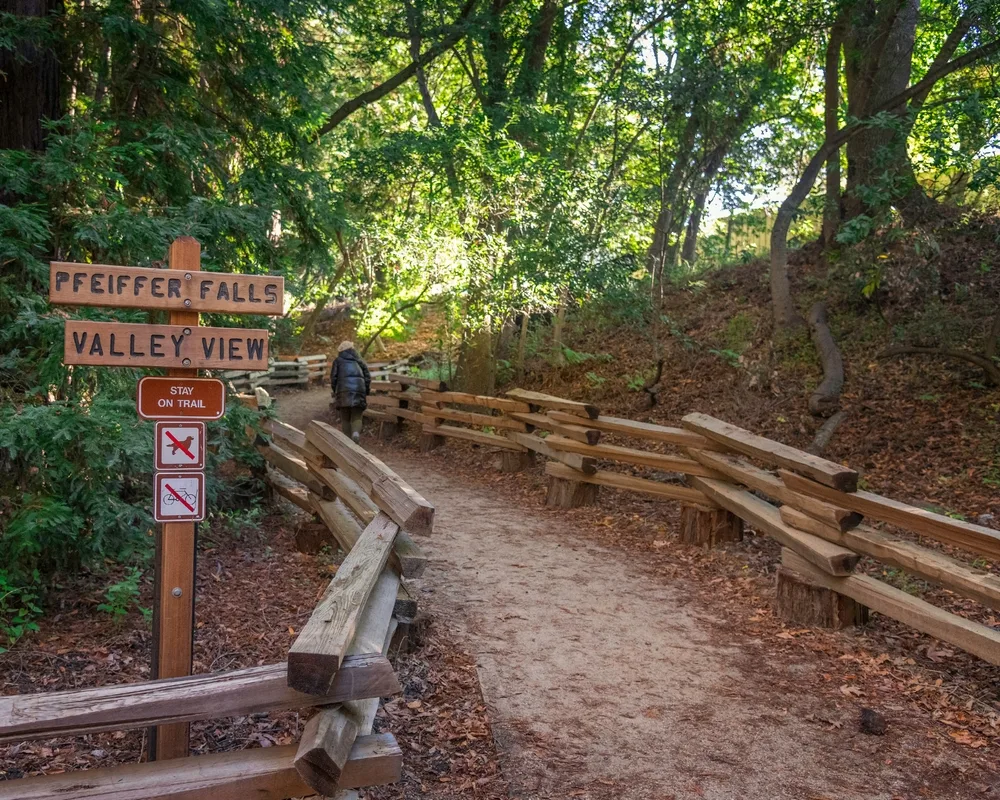
Gerry Matthews/Shutterstock
The least busy time to visit Big Sur is in January to March. The shorter, cooler days make the early months of the year a quieter time in Big Sur. However, adventurers can still find plenty to enjoy in this flourishing wilderness area.
Big Sur also contains the Los Padres National Forest, stretching more than two million acres along the California coast.
Those interested in camping, staying in a rustic yurt, or other thrilling wilderness experiences may need to trade off nice weather for affordable and available accommodations in Big Sur.
Be sure to call ahead well in advance to see if there are any reservations. Like other bustling tourist destinations, there is rarely a not-busy time to visit. With TV shows like HBO’s Big Little Lies and BBC’s Planet Earth, Big Sur is suffering from over-tourism.
This is making it difficult for the region to welcome and support eager travelers while still maintaining the natural environment that attracts tourists in the first place.
Be patient when visiting this iconic region of California at any time of year. While this is a less-busy time to visit Big Sur, there are still several festivals and celebrations to enjoy.
The high-end Big Sur Food and Wine Festival is held in the spring as well as nearby golf tournaments like February’s AT&T Pro-Am in Pebble Beach. Seek out JadeFest or WhaleFest to enjoy more of the natural beauty and joy of this part of the United States.
Worst Time to Visit Big Sur
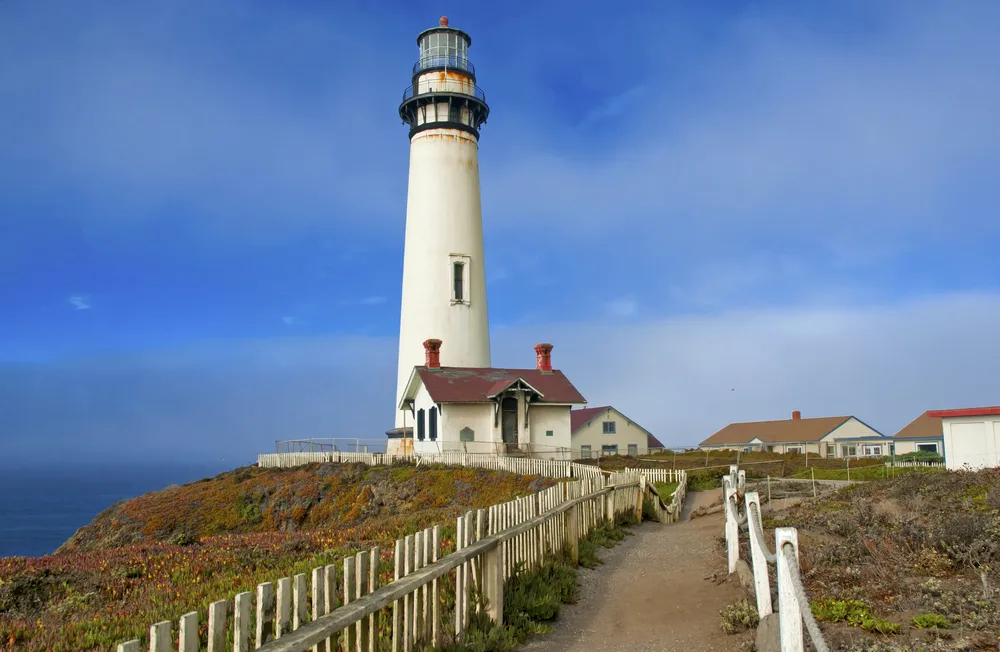
nyker/Shutterstock
The worst time to visit Big Sur is in the peak summer months of June, July, and August. If you are planning a trip here for a summer vacation, be prepared for an expensive and busy experience.
People swarm Big Sur during the summer for their child’s summer vacations or a romantic getaway for two. The best way to experience your full Big Sur moment is by driving down the iconically scenic Highway 1.
This world-famous road trip delivers amazing ocean, cliffside, and forest views for everyone riding in the car. However, Highway 1 maintains only two lanes.
This makes the trip to Big Sur an extremely slow pilgrimage. Also, frequent wildfires and landslides have cut off access to Big Sur for months or years at a time. Be informed and prepared for the various natural disasters that can occur in Big Sur.
The wildfire season typically stretches from August to October and the landslide season happens from November to February, especially in years after devastating wildfires. Consult your navigation app to find a time to make the drive in the busy summer months.
Or make sure your gas tank is full because there is nowhere to fill up with gas once you pass Carmel, California in the north or San Simeon, California in the south — a distance of more than 90 miles.
Big Sur by Month: Climate & Activities
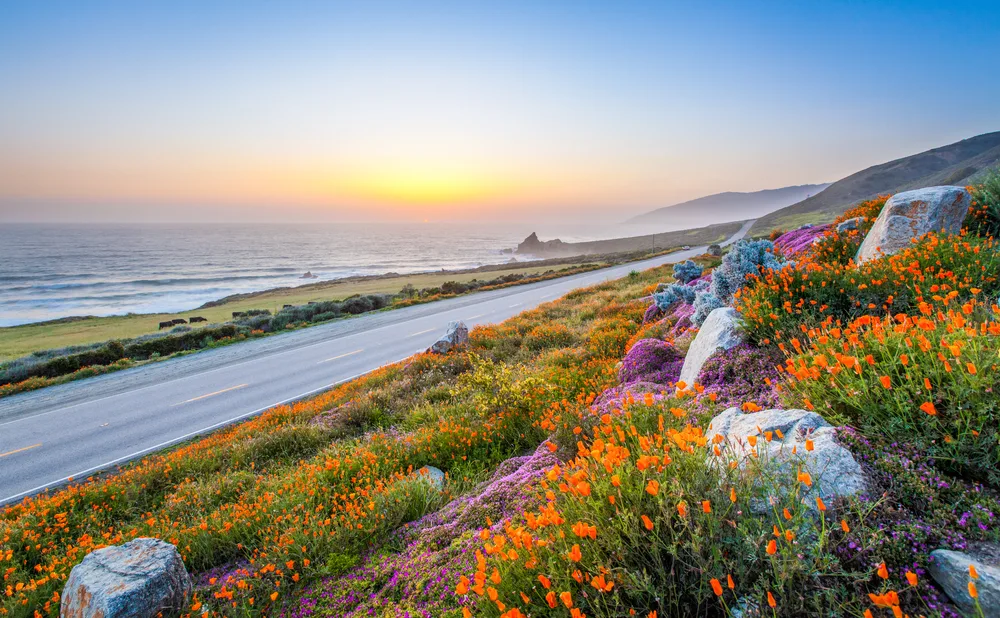
Kan_khampanya/Shutterstock
Still unsure about the best time to visit Big Sur? Take a look at our summary of the weather and climate by month below:
January
January in Big Sur offers cool, often rainy weather, with temperatures ranging from 8 to 15°C (46-59°F). This month is ideal for cozy stays in cliffside lodges, enjoying the dramatic ocean views, and exploring the indoor attractions like the Henry Miller Memorial Library.
February
February continues with cool and wet weather, perfect for spotting migrating gray whales, exploring the art galleries in Big Sur, and visiting the iconic Bixby Creek Bridge for stunning photography opportunities.
March
As spring approaches, temperatures in Big Sur range from 8 to 16°C (46-61°F). March is great for wildflower hikes in the hills, enjoying the lush greenery, and visiting Pfeiffer Beach to see the unique purple sand and rock formations.
April
April brings milder weather, with temperatures around 9 to 17°C (48-63°F). Enjoy exploring the Julia Pfeiffer Burns State Park, hiking to McWay Falls, and witnessing the vibrant spring blooms throughout the region.
May
May sees warmer temperatures from 10 to 18°C (50-64°F). It’s an excellent time for camping under the stars, exploring the coastal trails, and visiting the Point Sur Lighthouse for a guided tour.
June
June brings foggy mornings and pleasant days, with temperatures between 11 to 19°C (52-66°F). Enjoy scenic drives along the Pacific Coast Highway, visit the Andrew Molera State Park for hiking and beach activities, and explore the local farmers’ markets.
July
July is mild with temperatures from 12 to 20°C (54-68°F). Celebrate Independence Day with local festivities, enjoy whale watching tours, and explore the many tide pools along the Big Sur coastline.
August
August continues with mild weather, offering temperatures from 12 to 20°C (54-68°F). Visit the historic Point Sur Lightstation, enjoy the sunsets at Garrapata State Park, and explore the arts and crafts at the Big Sur Spirit Garden.
September
As fall begins in September, temperatures in Big Sur range from 13 to 21°C (55-70°F). September is perfect for enjoying the less crowded beaches, hiking in the cooler weather, and attending the annual Big Sur Jade Festival.
October
October sees cooler temperatures from 10 to 19°C (50-66°F). Enjoy the fall colors in the redwood forests, explore the quieter side of Big Sur, and visit the Ventana Wildlife Society’s Condor Sanctuary.
November
Fall temperatures in November range from 7 to 17°C (45-63°F). This month is ideal for cozy dining at Big Sur’s cliffside restaurants, enjoying the tranquil beaches, and exploring the many art galleries and shops.
December
Winter brings cooler temperatures ranging from 6 to 15°C (43-59°F). December is peaceful with fewer tourists, offering a serene experience of Big Sur’s natural beauty, and an opportunity to enjoy the local hot springs and spa retreats.
Frequently Asked Questions
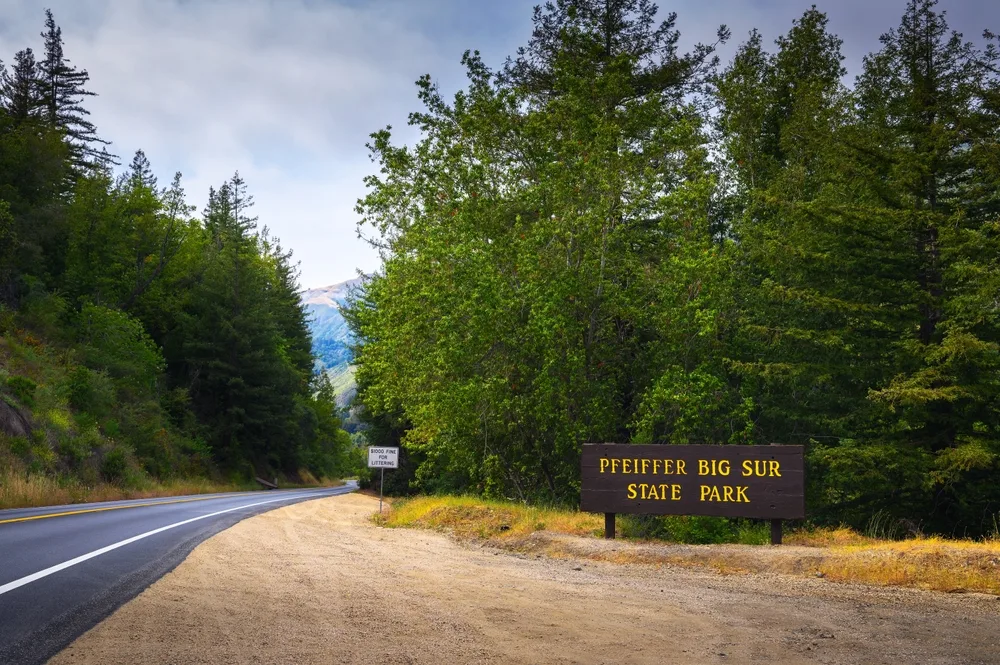
Nick Fox/Shutterstock
Here are some of the most common questions about Big Sur:
How many days do you need to see Big Sur?
Plan to spend at least two or three days experiencing all of the wonderful areas of Big Sur. This region stretches for millions of acres and includes several amazing parks and beaches. Leave a few days to explore a few thrilling natural spaces.
How much does it cost to visit Big Sur?
Costs in Big Sur vary greatly. Parking can cost between $10 to $15 at each park or wilderness area. Hotels range from about $200 to $300 each night to thousands nightly for luxury hotels. Restaurants and gas are also well above the average for other tourist regions due to their popularity and remote nature.
What are other popular destinations in Big Sur?
Pfeiffer Big Sur State Park boasts some of the tallest and oldest redwoods in Big Sur. Garrapata, Monastery, and Andrew Molera beaches provide amazing water views. Try cliffside restaurants for a romantic memory.
What is the official region of Big Sur?
Big Sur stretches for millions of acres along the central coast of California. Big Sur begins south of Carmel and envelopes several state parks and a national forest before ending just before Hearst Castle in the south. Driving the entire length of Big Sur land would take about 90 minutes with light traffic.
Can you do Big Sur without a car?
Yes! Locals are increasingly searching for efforts to reduce car traffic and preserve the beauty of Big Sur. Look into convenient public transportation offered by Monterey-Salinas Transit and work with the nonprofit Park-IT! to offer helpful and affordable shuttle service.
Are there dangerous animals in Big Sur?
An explosion of wildlife lives within the protected region of Big Sur. Mountain lions, bears, and other large predators exist in Big Sur but are rarely seen. Camping in Big Sur holds no larger risks than camping elsewhere.
Can you swim at Big Sur beaches?
No, it is never recommended to swim at Big Sur beaches. This region contains its characteristic rocky cliffs, making it dangerous for swimmers to navigate. The extremely cold water and unpredictable sneaker waves and rip currents make it unwise to swim at Big Sur beaches.
Is Yosemite on the way to Big Sur?
Many tourists make a trip to California’s iconic forests into an extended road trip. Yosemite lies more than 200 miles northeast of Big Sur. While this is a long drive, it isn’t unheard of to include both beautiful parks in one adventure.
Is it scary to drive to Big Sur?
Those with a fear of heights may regret looking over the side of the car window when traveling the winding roads of Big Sur. Highway 1 maintains only a two-lane highway, winding relentlessly through cliffs and along the Pacific Ocean. Attentive drivers can feel confident driving to Big Sur.
Is Big Sur walkable?
Those who have accessibility challenges may struggle to visit Big Sur. Parking isn’t varied so long as you need to walk to reach the entrance to parks like Point Lobos. Few paved paths exist within these natural surroundings, making it difficult for wheelchairs, walkers, or canes.
Why is sand pink in Big Sur?
Some of the rock formations within the cliffs of Big Sur generate vibrant pink and purple sands. As the region’s special Manganese garnet rocks erode, their purple residue colors the sand into this distinctive color.
So, What’s the Best Time to Visit Big Sur?
Big Sur experiences extremely high tourist traffic during all the months of the year. Those looking for the best weather and longest days should visit in the busiest seasons of June, July, and August.
Those willing to trade off the weather for lower prices and more peace and quiet should visit in January, February, or March. So what are you waiting for — book your trip to Big Sur today!



